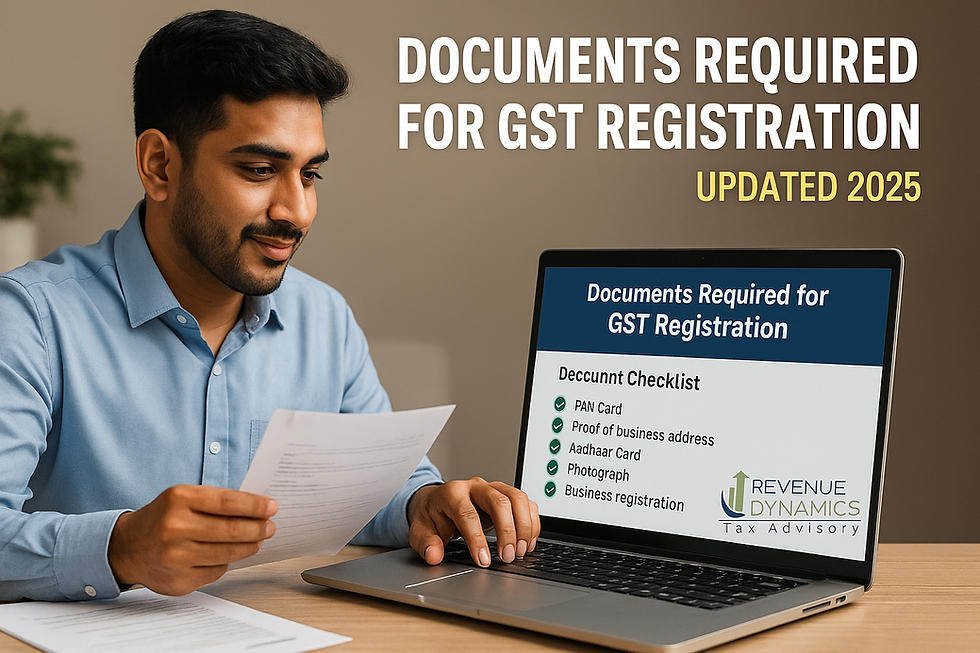New GST Return Filing System – Key Changes from 2025
- PRAVEEN DILLIBABU
- Nov 5
- 3 min read
Published by: Revenue Dynamics Tax Advisory
Date: 5th November 2025
Category: GST Updates / Compliance Reform
1. Introduction
The GST regime is undergoing a major transformation under the framework referred to as “GST 2.0”. As part of this, the Goods & Services Tax Network (GSTN) has announced a revamped GST Return Filing System effective from 2025. The aim: simplify monthly return filing, improve input tax credit (ITC) reconciliation, reduce errors, and streamline compliance for taxpayers.
2. Objective of the New System
This reform is designed to achieve the following:
Cut down on manual intervention and repetitive data entry
Boost the accuracy of ITC claims and reduce mismatches
Enable real-time invoice matching between suppliers and recipients
Provide taxpayers with an integrated dashboard for filings, payments, refund tracking, and data analytics
Encourage the formalisation of smaller businesses by lowering the compliance burden
3. Key Changes in the New Return Filing System
Feature | Under the Current System | Under New System (2025+) |
Return Forms | Separate filings: GSTR-1, GSTR-3B, GSTR-9 etc. | Unified forms: Smart return like FORM GST RET-1 (planned) |
Invoice Upload | Sales must be uploaded manually in GSTR-1; purchases rely on GSTR-2A/2B | Sales auto-populated from the e-invoice gateway; purchases and ITC auto-matched |
ITC Reconciliation | Manual cross-check & heavy corrections | Real-time matching, alerts on mismatch, and auto-locking of anomalies |
Payment/Tax Dashboard | Tax payment separate, return filing separate | One integrated dashboard: tax liability, reversal, and refund status |
Nil Return Filing | Nil-filers still manually file returns | “One-click” nil-return submission for eligible taxpayers |
Error Validation | Checks after returns filed | Pre-validation, AI/suggestive corrections, fewer post-filing amendments |
Note: Unified Forms: The GST Council has proposed a “Smart Return” system, represented by FORM GST RET-1, intended to replace GSTR-1 and GSTR-3B in the future. However, as of now (November 2025), this form has not yet been launched or implemented on the GST portal. The existing return structure continues to remain in force until official notification.
4. Advantages for Taxpayers
Time savings: With data auto-populated and fewer forms to file, tasks that took hours will take minutes.
Transparent ITC: Taxpayers will know their ITC position in real time, reducing surprise adjustments during audits.
Reduced errors: Built-in validation tools will lower mismatches, late fees, and audit triggers.
Increased formalisation: Especially smaller taxpayers (with liability ≤ ₹2.5 lakh per month) will gain from simpler registration and filing.
Better readiness for digital ecosystem: The integration of data across the GST portal, e-invoicing, payment, and refund systems ensures smoother compliance.
5. Implementation Timeline
From 1 November 2025: The simplified registration/auto-approval system for new applicants begins — eligible businesses will receive GST registration within three working days.
From July 2025 onwards: Two significant compliance changes already in motion: a time-bar of three years for filing delayed returns and a hard-lock on editing certain pre-populated values in GSTR-3B.
Ongoing: Other reform modules (like integrated dashboards, refund automation, unified smart return) will be phased in through FY 2025-26. Stakeholders are advised to stay updated as the GSTN issues detailed notifications.
6. Compliance Preparation for Businesses
To ensure you’re not caught off guard, take these steps now:
Reconcile your purchase/sales ledger and match with your GSTR-2B and GSTR-1 records.
Enable e-invoicing for your business if applicable — this will ensure seamless upstream data flow.
Upgrade your accounting software or coordinate with your tax professional to integrate with GSTN APIs or portal features.
Ensure all authorised signatories/promoters have Aadhaar, mobile & email verified (as future filings will rely heavily on authentication).
Train your team or accountants to use dashboards and handle auto-populated returns — the earlier you adapt, the fewer surprises later.
Monitor GSTN portal advisories and set internal deadlines ahead of legal due dates.
7. Conclusion
The upcoming reform of the GST Return Filing System marks a significant milestone in India’s indirect tax journey. With automation, real-time data matching, and simplified processes, taxpayers—especially small and medium enterprises—stand to benefit from faster, more accurate compliance.
At Revenue Dynamics Tax Advisory, we’re fully equipped to guide businesses through every phase of this transformation: from registration to monthly filing, from ITC reconciliation to audit readiness. Embrace the change — file confidently, comply seamlessly, and stay ahead.
👩💼 About Revenue Dynamics Tax Advisory
At Revenue Dynamics Tax Advisory, based in Chennai, we offer expert services in GST registration, GST filings, income tax, bookkeeping, and full business compliance.
"We handle the numbers, so you build your business."
📞 Contact Us: +91 97106 75224
🌐 Website: www.rdtaxadvisory.in
📧 Email: revenuedynamicsadvisory@gmail.com




Comments